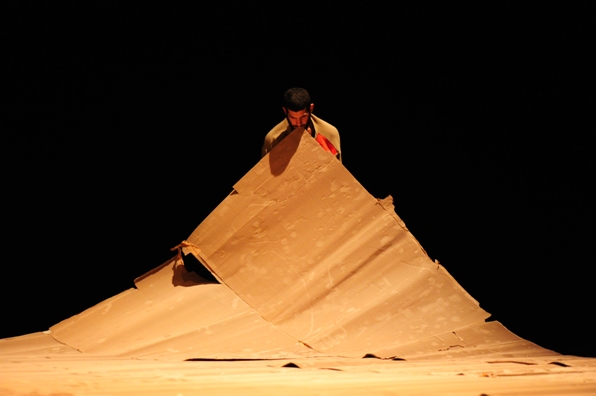
Homesick – the two words push against one another, igniting sparks. Distance is embedded in this semantic union, in order to feel homesick, it is first necessary to be far from home, a distance geographic and emotional. Iris Erez, a performer of fierce intensity and radical grace, has introduced distance between herself and her choreography in the past two years, creating two works in which she does not perform: Numbia (2009) and Homesick (2010). Homesick, which premiered in the 2010 Curtain Up Festival at Suzanne Dellal, will be performed at the Suzanne Dellal Centre in Tel Aviv on Monday, September 12, 2011, as a full-length evening, preceded by one of Erez’s earlier solo works, Temporary, which premiered at the 2007 Operastate Festival in Bassano, Italy.
Working from the material – the body, its movement and physical environment, the juxtaposition of Temporary and Homesick generates reflection on themes of home and identity in which images of striking beauty elicit disturbing questions. Temporary, originally performed by Erez, is currently performed by Maya Weinberg, a dancer and choreographer who brings her own distinct qualities to the piece. Conjuring the vocabulary of homelessness, the piece begins with Weinberg staggering, hidden under the bundle of clothing she carries. The clothes fall from her hands and layers of meaning accrue over time, as she moves through different states. At times there is a fluid ease and flow to her movement, youthful, limber, groovy. At other moments it feels as though there is an almost desperate attempt to move up or out of the body itself. An experience of homelessness in the body; what we let fall and what we hold close.
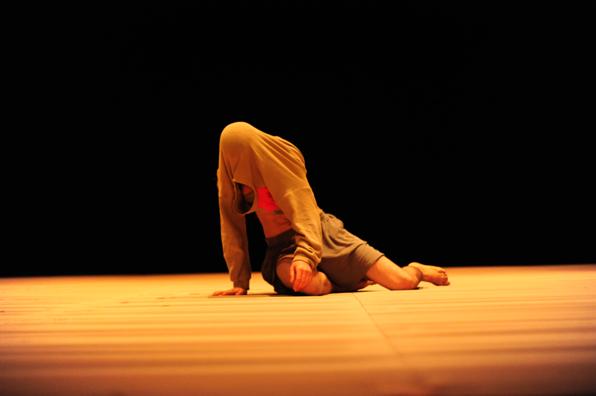
Homesick opens with a vision of warm glowing sands, a mythological desert landscape created out of corrugated cardboard that covers the stage. A man (Asaf Aharonson) lies on the ground, then sits up, puts his shirt on his head and begins to flail in agitated, energetic movement, dives, spins, bounces and flips his body over the cardboard surface, then crawling under one corner. Another man (Ofir Yudilevitch) enters the space, eyes looking up to the sky and arms out to his sides, there is lightness to his step as he leaps and turns. Music enters the silence of the stage: “these rocks don’t care if I live or die.”
If Temporary relates to a more abstract and conceptual space, Homesick, while devoutly abstract, inevitably generates local contemporary associations. Erez makes a conscious and provocative choice in translating the title Homesick to Hebrew. There is no direct parallel, yet rather than use a term that that expresses a longing or desire for home, such as געגועים (transliteration: ga’aguim), Erez has chosen a literal translation of the two words that form the compound: חולה בית, literally – home sick. The separation places an equal emphasis on both words, and questions the connection between them.
Is home a place one longs for, is it something that makes one sick? Is the home itself sick, is the longing for a home that is not sick, or is the longing for home itself a kind of sickness, that consumes and destroys. My home is making me sick, my home is sick, and I long for home. It is a sickness that recalls the Song of Songs: “I am sick of love.” If Temporary expresses a kind of homelessness within the body, Homesick embodies not only the longing to feel at home, but a kind of longing and sickness that one feels at home.
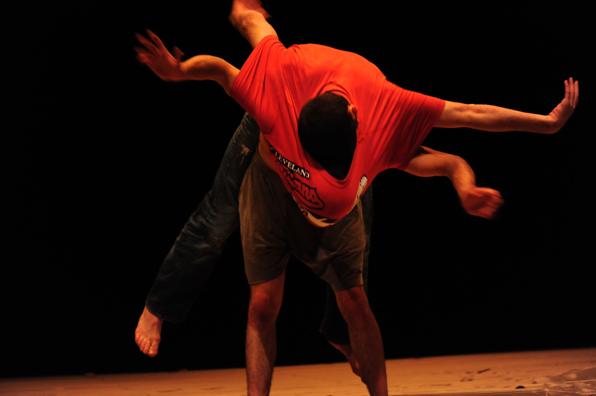
Another common theme within the two works is the relationship between internal and external, with clothing taking on a symbolic aspect. There are several sequences in Homesick in which clothing shapes or represents relationships, pulling a shirt over the head, or literally taking the shirt off another dancer’s back. Identifying with the external representation of another, wearing his shirt, transforms identity as well. When Asaf wears Ofir’s shirt, his movements resemble those of Ofir – light steps, arms uplifted.
The third figure in this complex landscape is a female dancer – Tami Leibovitch. Where Asaf burrows under the land, Tami tears small pieces of it, letting them fall to the ground or putting them inside her shirt. Finally, tearing large swaths of cardboard and gathering them up around her, she seeks refuge in the raiment of homelessness. Throughout the work there is a jarring beauty to the scenes of alienation and destruction, enhanced by Ram Gabai’s soundtrack (Reckless Feet). Seeking to find their place and way of being in relation to one another and the land itself, each of the three remains alone; the stage empty, a ravaged land.
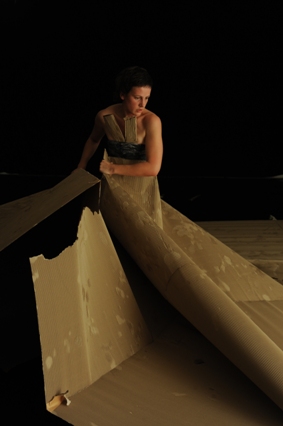
Homesick will be performed on Monday, September 12, 2011 at the Suzanne Dellal Centre in Tel Aviv. Tickets: 03-5105656.
Temporary
Choreography: Iris Erez
Performance: Maya Weinberg
Music: Hanayo
Musical editing: Jeremie Bernheim and Yaniv Mintzer
Homesick
Choreography: Iris Erez
Dancers/creators: Asaf Aharonson, Ofir Yudilevitch, Tami Leibovitch
Soundtrack: Reckless Feet
Music: Reckless Feet, Mount Eerie, A Silver Mt. Zion
Costumes: Inbal Leiblich, Tamar Levit
Set design consultant: Hila Ben Ari
Artistic direction: Tamar Borrer
Lighting design: Tamar Or
Producer: Alon Schwabe


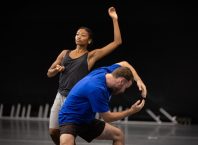



Comments are closed.